 |
 |
 |
|
|
|
  |
The land mark and a historic spot, a historical walk way
Tempozan Ferry
Address: 10, Sakurajima 3-chome, Konohana-ku, Osaka
Transport: 350m south of the "Sakurajima 3-chome" City Bus Stop |
Originating in the late Meiji Period, this ferry connects Sakurajima in Konohana-ku with Tempozan (Chikko 3 chome) in Minato-ku. At one time there were up to ten ferries operating within the ward along the Ajigawa River, but currently only one ferry remains at Tempozan. The ferry service operates every 15mins to 30mins from 6:00am to approximately 8:00pm daily. |
 |
The Former Nippon Steel Casting Works
Address: 2, Nishikujo 7-chome, Konohana-ku, Osaka
Transport: 800m south of the "Konohana kuyakushomae" City Bus Stop |
The Osaka Steel Casting Works laid the foundations for the development of the Western-style shipbuilding industry in Osaka. They were built on this site in 1880 by the British Japanophile E. H. Hunter. The Steel Casting Works were later relocated to Sakurajima and became Hitachi Zosen. |
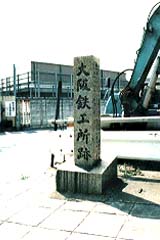 |
The Grave of Agricultural Land Developer Tsuneyoshi
Address: 11, Torishima 5-chome, Konohana-ku, Osaka
Transport: 600m east from the "Tsuneyoshi 1-chome" City Bus Stop |
This memorial was built in 1908 on the fiftieth anniversary of the death of Tsuneyoshi Shozaemon, the last agricultural land development contractor of the Edo Period in Konohana-ku. The grave also commemorates the victims of the tsunami of 1854 (although the memorial itself records this event as occurring in 1856) Until the Taisho Period, this area was covered with magnificent pine trees and was known as "Senbonmatsu", meaning "One Thousand Pines", but no traces of these remain today. |
 |
Fuel Car Accident Victims Memorial
Address: 1, Shimaya 4-chome, Konohana-ku, Osaka
Transport: 400m south from the "Shimaya" City Bus Stop or near JR Ajigawaguchi Station |
The inscription on this memorial reads, "Namu Amida Butsu - Homage to Amida Buddha. Dedicating to Buddha the souls of the 189 who died. 01.29.1940" In January 1940, against the background of the expanding war being fought on the Chinese mainland, the last of three fuel cars on a train carrying around 1,000 so-called "industrial warriors" derailed, overturned and went up in flames. This memorial commemorates those workers who died in the accident.
|
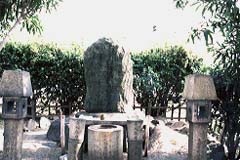 |
The Former Main Store and Home of the Konoike Family
Address: 3, Denpo 4-chome, Konohana-ku, Osaka
Transport: Approximately 250m east from Denpo Station on the Hanshin Nishi-Osaka Line |
Built in 1911, the wooden, two-storied Western-style annex and the Japanese-style living quarters on the eastern side of the building provide an example of combined Western and Japanese architecture. Though partly remodeled in 1914, the shop and living quarters still retain the architectural style and furnishings of the times.. |
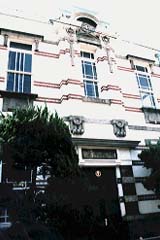 |
Koshindo Hall
Address: 8, Denpo 5-chome, Konohana-ku, Osaka
Transport: Approximately 300m north from the "Torishima 2-chome" City Bus Stop or
500m west from Denpo Station on the Hanshin Nishi-Osaka Line
|
Located in Saru-mura (once Denpo 5 chome) within the precincts of the former Sumiyoshi Shrine, this hall retains its importance for local believers even now. "Kukurizaru" - good luck talismans made from cloth and resembling monkeys - are offered here, and ritual events are still held that retain the character of the Koshin Cult from the Edo Period. Nowadays it has embraced syncretism and is dedicated to the god Sarutahiko-Okami.
|
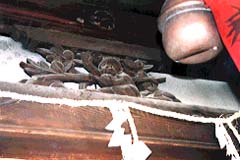 |
The Denpo Floodgates
Address: Denpo 5-chome, Konohana-ku, Osaka
Transport: Approximately 350m northwest from the "Torishima 2-chome" City Bus Stop |
A long time ago this area was the mouth of the Denpo River and ships from around the country stopped here making it a thriving port. During Emperor Genroku's reign, fewer ships came due to the construction of the Ajigawa River, but it still retained the appearance of a small city. The floodgates were built when the Denpo River was filled in as part of high tide control measures in 1954 at which time a section of the river became a fishing port. |
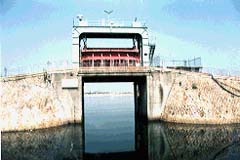 |
Ubusuna Jinja Shrine
Address: 13, Shimaya 3-chome, Konohana-ku, Osaka
Transport: Near the "Shimaya" City Bus Stop |
This shrine was built in 1762 on the left bank of the Shorenjigawa River at a spot now in the grounds of Sumitomo Denko. It was founded by Asada Ichibei, a Shimaya from Osaka, as the protector of the newly developed agricultural land. It was moved to its present location in 1934 after sustaining flood and typhoon damage. A memorial within the shrine compound commemorates the recovery of the former Onkijima-cho and Shimaya-cho from flood damage.
|
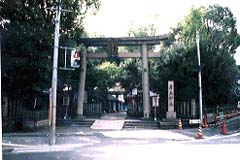 |
Sainenji Temple
Address: 7, Denpo 5-chome, Konohana-ku, Osaka
Transport: Approximately 200m northeast from the "Torijishima 2-chome" City Bus Stop |
.According to the monk ‚senjikunanzandoyuritsushi the temple
was founded by the Buddhist scholar Hodo in 645 as a training
hall from which to spread the teachings of Buddhism. Between
the 12th and 16th centuries it attracted believers as
the Funadera temple of the Setsudenpo and prospered as
one of the four main temples of Setsu, Kawachi and Izumi.
The current Denpo Elementary School was built here in
1873.
|
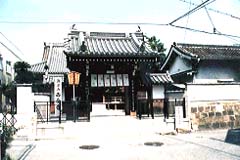 |
Shorenji Temple
Address: 4, Denpo 6-chome, Konohana-ku, Osaka
Transport: Approximately 150m south from the "Torishima 2-chome" City Bus Stop |
Shorenji Temple is said to have originated with the construction of a small hermitage in 1625 by Shoren Nichiho. It once had a full array of halls and living quarters and was counted among the 25 temples of Osaka. However, all the buildings were lost to fires and earthquakes and the present main hall dates from 1874. The temple's "Kawasegaki" ceremony is held every year on August 26 and dates back to 1721. It has been renowned since the Edo Period as one of the three biggest Kawasegaki ceremonies in Japan. There is a marker from the old Amagasaki Kaido Highway in front of the temple gate.
|
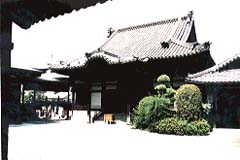 |
Asahijshinmeisha Shrine
Address: 6, Kasugadenaka 1-chome, Konohana-ku, Osaka
Transport: 250m south from the "Kasugade" City Bus Stop |
The shrine is part of Kotai-Jinja Shrine, the guardian deity of Kawagishi-cho, (built during Emperor Tenpo's reign in the 1830's) and also one of the three Shinmeisha shrines in Osaka. Joining Asahishinmeigu in what was once Chuo-ku (the old Higashi-ku), it was renamed Asahishinmeisha in 1908 and moved to its current location in 1931. In 1994 it received the old Kasugataishahonguu and "Kasugasha" was rebuilt.
|
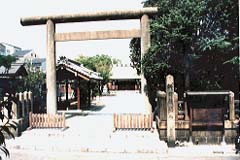 |
Sumiyoshi Jinja Shrine
Address: 14, Baika 3-chome, Konohana-ku, Osaka
Transport: Approximately 200m south of the "Shikanjima 2-chome" City Bus Stop |
Locals involved in fishing and cultivating new farmland built the shrine along the banks of the Shorenjigawa River (in the Shikanjima 1 chome area) around the year 1620 in honor of Sumiyoshi Okami, the guardian deity of the sea. It was later shifted to what is now Baika 1 chome, before finally moving to its present location in 1922 to make way for the municipal tram. |
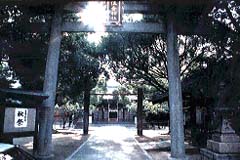 |
Miotsukushi Sumiyoshi Jinja Shrine
Address: 1, Denpo 3-chome, Konohana-ku, Osaka
Transport: Approximately 200m east from Denpo Station on the Hanshin Nishi-Osaka Line |
According to the traditions of the shrine, the shrine itself originated in the year 804 when an altar was set up and a channel marker put in place to wish the scholars sent to T'ang Dynasty China a safe journey and a safe passage home. As the area prospered as a gateway to the country for Buddhist teachings the shrine and its precincts were renewed and the guardian deity of the land and safe voyages at sea enshrined there. Vestiges of that era still remain today.
|
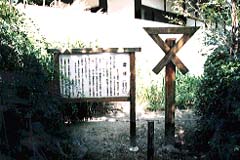 |
Hasshuken Ruins
Address: In Kasugade Park, Kasugademinami 1-chome, Konohana-ku, Osaka
Transport: Approximately 500m southeast from the "Konohana Kuyakushomae" City Bus Stop |
The development of agricultural land in Osaka began flourishing during the years of Emperor Genroku's reign in the Edo Period (the end of the 17th century) This area was developed by Zakkaya Shichibei and called Kasugade Shinden. Hasshuken was the name of the garden at a club in that vicinity. It was purportedly named Hasshuken because one was able to see all the eight states of Settsu, Kawachi, Izumi, Kii, Awaji, Satsuma, Yamashiro and Yamato from there. (Hasshuken translates as "Villa of the Eight States") Part of the building was moved to Yokohama in 1907 and still remains there as an Important Cultural Treasure, but the rest was burned down during the Second World War. This monument was erected in 1962 to mark the 70th anniversary of the municipal government.
|
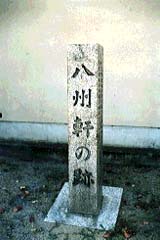 |
Karasunomiya
Address: 10, Denpo 2-chome, Konohana-ku, Osaka
Transport: Approximately 400m north from the "Shikanjima 2 chome" City Bus Stop at Morisubashi Kitazume |
This shrine is said to have originated in 1215 when sailors wishing for the prosperity of the harbour established Morisu Jinja Shrine as the local guardian deity. It was later renamed Karasunomiya (lit. "The Crow Shrine") after Hideyoshi procured a safe ocean journey for his troops by sending them out with a three-legged crow to lead them.
|
|
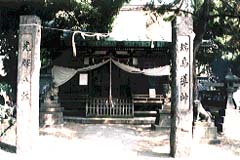 |
|
|
Nishikujo
Jinja Shrine
Address: 4, Nishikujo 1-chome, Konohana-ku, Osaka
Transport: 300m east from JR Nishikujo Station or the
"Nishikujo" City Bus Stop
|
|
Said to have originated in 1680
when settlers in Nishino Shinden prayed for a good harvest
to Sumiyoshi Okami as the god of Inari Taisha Shrine
and as the guardian deity of the sea. In 1908 it became
Ibara Sumiyoshi Jinja Shrine's temporary stopping place
for the Emperor before changing its name to Nishikujo
Jinja in 1946. In the years before the Second World
War, the Emperor used to make appearances at the shrine
but now no longer does so.
|
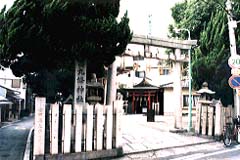 |
|
|
Ajigawa River
Tunnel
Address: Nishikujo 2-chome, Konohana-ku, Osaka
Transport: Approximately 250m south from JR Nishikujo
Station or from Nishikujo Station on the Hanshin Nishi-Osaka
line
|
|
There used to be several ferries
crossing the Ajigawa River, and one of these, the Genpei
Ferry, has been replaced by a tunnel. It provides a
shortcut between Konohana-ku and Nishi-ku. It was built
to help deal with the increase in traffic flow and was
completed in 1944. With the opening of the Ajikawa River
Bridge in 1963, the amount of traffic using the tunnel
decreased and it can now only be used by pedestrians
and cyclists.
|
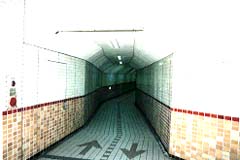 |
|
 |
|
 |
|
 |

